Discovery of 1300 Year Old Maya Text References 2012 Mayan End Date
QUANTUM DAY, 21st Century Science, Technology and Medicine News, June 29, 2012
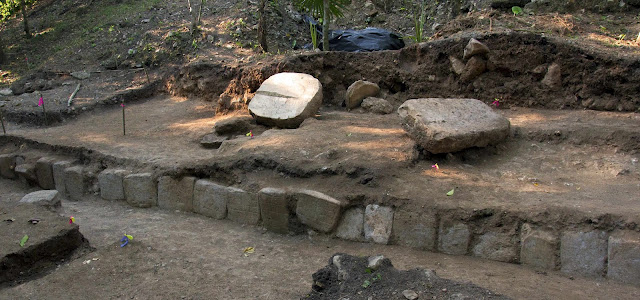
1300 year old Mayan stone carvings discovered in La Corona, Guatemala
Much attention has been drawn to the Mayan calendar. The calendar follows a Mesoamerican Long Count Calendar where a 5,125 year long cycle is believed to end on 21 December 2012.
Speculation abound to what the Mayans were expecting on the end date of the calendar. Some believe it is a doomsday prediction and the world will end on that day. Although there is no scientific or even historical proof of this belief, this interpretation on the end of the long count calendar is much talked about.
Scenarios believed to happen on that day are numerous. The sun will release a massive solar flare, the Earth's pole will shift, the Earth will collide with another space object such as an asteroid, etc. etc.
Scientists and historians have dismissed the notion of these doomsday predictions.
NASA's website, Astrobiology, state that, "Calendars exist for keeping track of the passage of time, not for predicting the future. The Mayan astronomers were clever, and they developed a very complex calendar. Ancient calendars are interesting to historians, but they cannot match the ability we have today to keep track of time, or the precision of the calendars currently in use. The main point, however, is that calendars, whether contemporary or ancient, cannot predict the future of our planet or warn of things to happen on a specific date such as 2012..."
Maya archaeologists unearth new 2012 monument
Archaeologists working at the site of La Corona in Guatemala have discovered a 1,300-year-old-year Maya text that provides only the second known reference to the so-called "end date" of the Maya calendar, December 21, 2012. The discovery, one of the most significant hieroglyphic finds in decades, was announced today at the National Palace in Guatemala.
"This text talks about ancient political history rather than prophecy," says Marcello A. Canuto, director of Tulane's Middle American Research Institute and co-director of the excavations at La Corona.
Interview with Canuto and Steward Regarding La Corona Excavation
Since 2008, Canuto and Tomás Barrientos of the Universidad del Valle de Guatemala have directed excavations at La Corona, a site previously ravaged by looters.
"Last year, we realized that looters of a particular building had discarded some carved stones because they were too eroded to sell on the antiquities black market," said Barrientos, "so we knew they found something important, but we also thought they might have missed something."
What Canuto and Barrientos found was the longest text ever discovered in Guatemala. Carved on staircase steps, it records 200 years of La Corona history, states David Stuart, director of the Mesoamerica Center at The University of Texas at Austin, who was part of a 1997 expedition that first explored the site.

Carved stone block discovered at La Corona
While deciphering these new finds in May, Stuart recognized the 2012 reference on a stairway block bearing 56 delicately carved hieroglyphs. It commemorated a royal visit to La Corona in AD 696 by the most powerful Maya ruler of that time, Yuknoom Yich'aak K'ahk' of Calakmul, only a few months after his defeat by long-standing rival Tikal in AD 695. Thought by scholars to have been killed in this battle, this ruler was visiting allies and allaying their fears after his defeat.
"This was a time of great political turmoil in the Maya region and this king felt compelled to allude to a larger cycle of time that happens to end in 2012," says Stuart.
So, rather than prophesy, the 2012 reference places this king's troubled reign and accomplishments into a larger cosmological framework.
"In times of crisis, the ancient Maya used their calendar to promote continuity and stability rather than predict apocalypse," says Canuto.
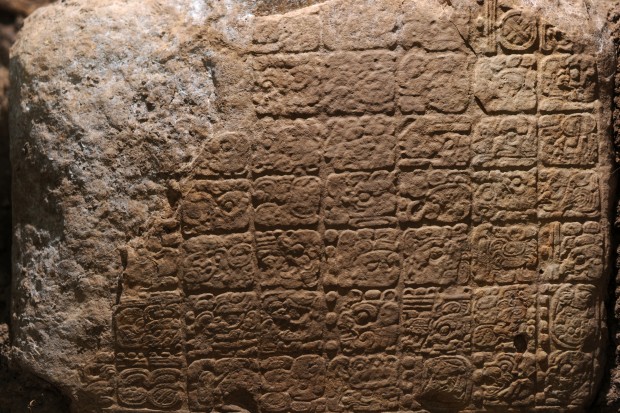
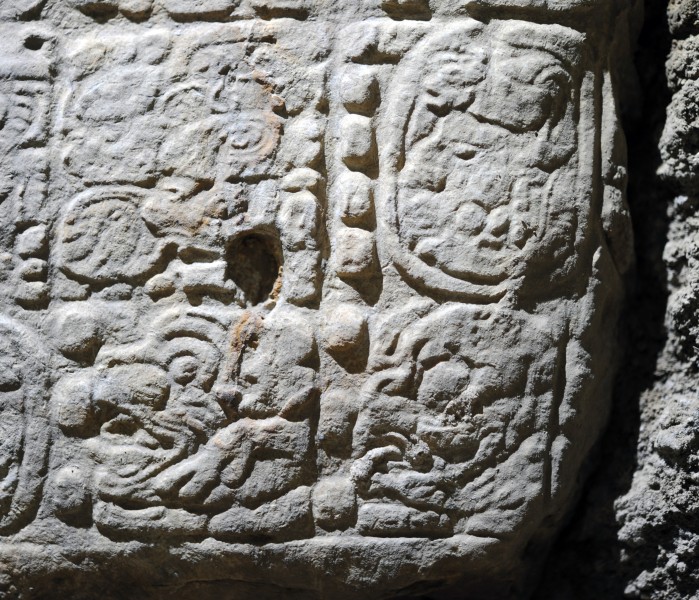
ººººººººººººººººººººººººººººººººººººººººººººººººººººººººººººººººººººººººººººººººººººººººººººººººººººººººººººººººººººº
The University of Texas at Austin, „Know“, 29. Juni 2012
Maya Scholar Deciphers Meaning of Newly Discovered Monument That Refers to 2012
By Paola Bueche, College of Fine Arts, Published: June 28
A publishing and entertainment empire has arisen around the supposed Mayan “end date” of December 21, 2012. But a second reference to the date, discovered only recently in Guatemala by a team including UT’s David Stuart, further debunks the theory that the Maya expected the world to end. In this slideshow, including images from National Geographic, see the discovery at La Corona and read how the Maya used the date simply as “a literary device.”
Archaeologists working in the jungles of Guatemala have discovered an ancient Maya text that refers to the so-called end date of the Maya calendar, Dec. 21, 2012. The hieroglyphic inscription was unearthed in April at the ruins of La Corona, located in the dense rainforest of northwestern Guatemala, and deciphered by David Stuart of The University of Texas at Austin during his research at the site in May.
The text is one of many found this year by an international team led by archaeologists from Tulane University and the Universidad del Valle de Guatemala. Among their discoveries are portions of the longest text ever discovered in Guatemala, carved on multiple staircase steps and recording 200 years of La Corona’s history, now being closely studied by Stuart and his colleagues. The discovery, perhaps the most significant hieroglyphic find in decades, was announced at a news conference held this morning at the National Palace in Guatemala City.
The stone referring to the year 2012 was carved to commemorate a royal visit to La Corona (which the ancient Maya called Saknikte’) by the ruler Yuknoom Yich’aak K’ahk’ from the great Maya capital of Calakmul on Jan. 29, 696 A.D. Before the discovery, this ruler was thought by scholars to have been killed in battle, when Calakmul was defeated by its great rival, Tikal. But the new find makes it clear that Yuknoom Yich’aak K’ahk’ was visiting allies — such as La Corona — in the wake of this defeat, possibly soothing their fears after such a significant military loss.
Why the reference to the year 2012? “The reason mostly has to do with the cosmological dimensions of ancient Maya politics and kingship,” says Stuart. “Calakmul’s king had only recently celebrated an important ending of 13 K’atun calendar cycle, in the year 692 (9.13.0.0.0), and in this text he is called a “13 K’atun lord.” The scribe has used this important ritual fact to project forward to when the next higher period of the Maya calendar will also reach 13 — a sacred Maya number — which will come on Dec. 21, 2012 (13.0.0.0.0).”
It is in this context that we have only the second reference to the “end date” in the entire corpus of ancient Maya writing, according to Stuart. This text uses the 2012 date to put this king’s troubled reign and accomplishments into a larger cosmological framework.
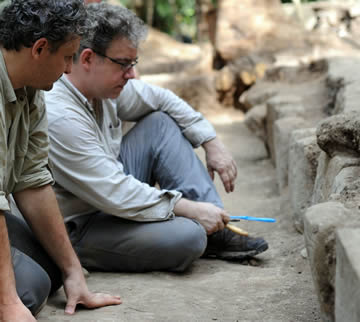
Marcello Canuto (Tulane University) and UT Professor David Stuart.
“This new evidence suggests that the 2012 date was an important calendrical event that would have been celebrated by the ancient Maya; however, they make no apocalyptic prophecies about it whatsoever,” says Marcello Canuto, director of Tulane’s Middle American Research Institute and co-director of the excavations at La Corona. Since 2008, Canuto and Tomás Barrientos of the Universidad del Valle de Guatemala, have directed excavations at La Corona. Stuart was part of a 1997 expedition that first explored and documented the ruins, when he named it La Corona (“The Crown”) after a distinctive building seen in the forest there — a line of five closely spaced small pyramids.
Stuart’s decipherments at La Corona come shortly after another significant find announced earlier this year — the discovery of a painted structure at the ruins of Xultun, Guatemala, containing what is thought to be the work space of a scribe or calendar priest. Stuart collaborated with William Saturno of Boston University, who directs the Xultun excavations, to decipher the unique paintings found on the walls of the small structure.
“I was at the ruins of Xultun when the paintings were initially discovered in 2010 and also during spring break this year,” Stuart says. “As the paintings were being uncovered in 2011, I was sent scans and photographs of the images and began deciphering the mathematical and astronomical tables last summer.”
The structure is covered with tiny red and black numbers and hieroglyphs, unlike any seen before at other Maya sites. These appear to be notations, written by the scribes as they were working and carrying out calendrical calculations, similar to a modern mathematician’s office whiteboard. Some numbers appear to represent the various calendrical cycles charted by the Maya — the 260-day ceremonial calendar, the 365-day solar calendar, the 584-day cycle of the planet Venus and the 780-day cycle of Mars, reports lead excavator Saturno. Saturno and Stuart reported their findings in a paper they co-authored for the journal Science titled, ”Ancient Maya Astronomical Tables from Xultun, Guatemala.”
Stuart’s main contribution was to read and reconstruct the numbers, many of which were poorly preserved. He also identified the nature of the tables as ancient tools for calendrical calculations, including lunar cycles. Finally, he carefully copied the texts so colleagues and future scholars can also study them. His field time in March involved working directly with the paintings and texts before they were closed and eventually reburied — the best means of ensuring their preservation in the remote jungle.
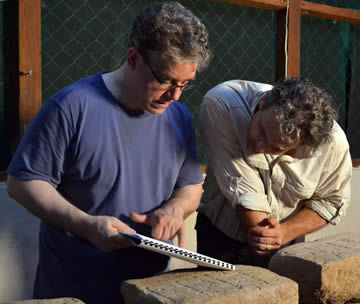
David Stuart and Marcello Canuto examining looted panels.
“It was incredible being in an ancient room where scribes and calendar priests were once working on their calculations, perhaps even discussing them,” says Stuart. “The day after I reconstructed the very damaged lunar table from Xultun, I shared the exciting news with undergrads who were in the UT study abroad program in Antigua, Guatemala.
“As a fun exercise, I had the students figure out the how the ancient Maya would have written each column in the table, using bars and dots. On the whiteboard in our classroom we wrote the table as it would have originally looked — 27 columns of Maya numbers. It was the first time it had ever been reconstructed visually, and it was a really special moment.”
Stuart is the David and Linda Schele Professor of Mesoamerican Art and Writing at The University of Texas at Austin. He is the author of the popular book on the Maya calendar, “The Order of Days: The Maya World and the Truth about 2012.” Stuart’s research is supported by the Schele research fund from the College of Fine Arts at The University of Texas at Austin and through the Casa Herrera research facility in Guatemala, where he does much of his work throughout the year.
